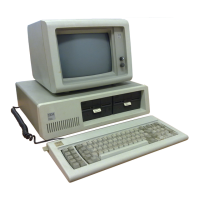I/O Channel
The
I/O
channel
is
an extension
of
the 8088 microprocessor bus.
It
is, however, demultiplexed, repowered, and enhanced by the addition
of
interrupts and Direct Memory Access
(DMA)
functions.
The
I/O
channel contains an 8-bit bidirectional data bus, 20 address
~
lines, 6 levels
of
interrupt, control lines for memory and
I/O
read or
write, clock and timing lines, 3 channels
ofDMA
control lines, memory
refresh timing control lines, a channel check line, and power and ground
for the adapters.
Four
voltage levels are provided for
I/O
card +5 V dc, -
5 V dc,
+12 V dc, and -12 V dc. These functions are provided in a 62-pin
connector with 100 mil card tab spacing.
A ready line
is
available on the
I/O
channel to allow operation with
slow
I/O
or memory devices.
If
the channel's Ready line is not
activated by an addressed device, all processor generated memory
read and write cycles take four 210 ns clock or 840 ns/byte. All
processor-generated
I/O
read and write cycles require five 210 ns
clocks or 1.05 m sec/byte. All
DMA
transfers require five clocks for a
cycle time
of
1.05 m sec/byte. Refresh cycles are present once every 72
clocks or approximately
15
m sec and require five clocks or approxi-
mately
7%
of
the bus bandwidth.
I/O
devices are addressed using
I/O
mapped address space. The
,,--......,
channel is designed so that 512
I/O
device addresses are available to
the
I/O
channel cards.
A channel check line exists for reporting error conditions to the
processor. Activating this line results in a
NMI
to the 8088 processor.
Memory Expansion Options use this line to report parity errors.
The
I/O
channel
is
repowered so there
is
sufficient drive to power
all
five
System Expansion Slots, assuming two loads per slot. The
IBM Option
I/O
adapters typically use only one load. A graphic
illustration
of
the System
I/O
Channel and its descriptions are on the
following pages.
2-8

